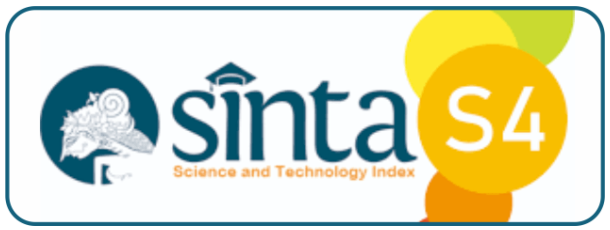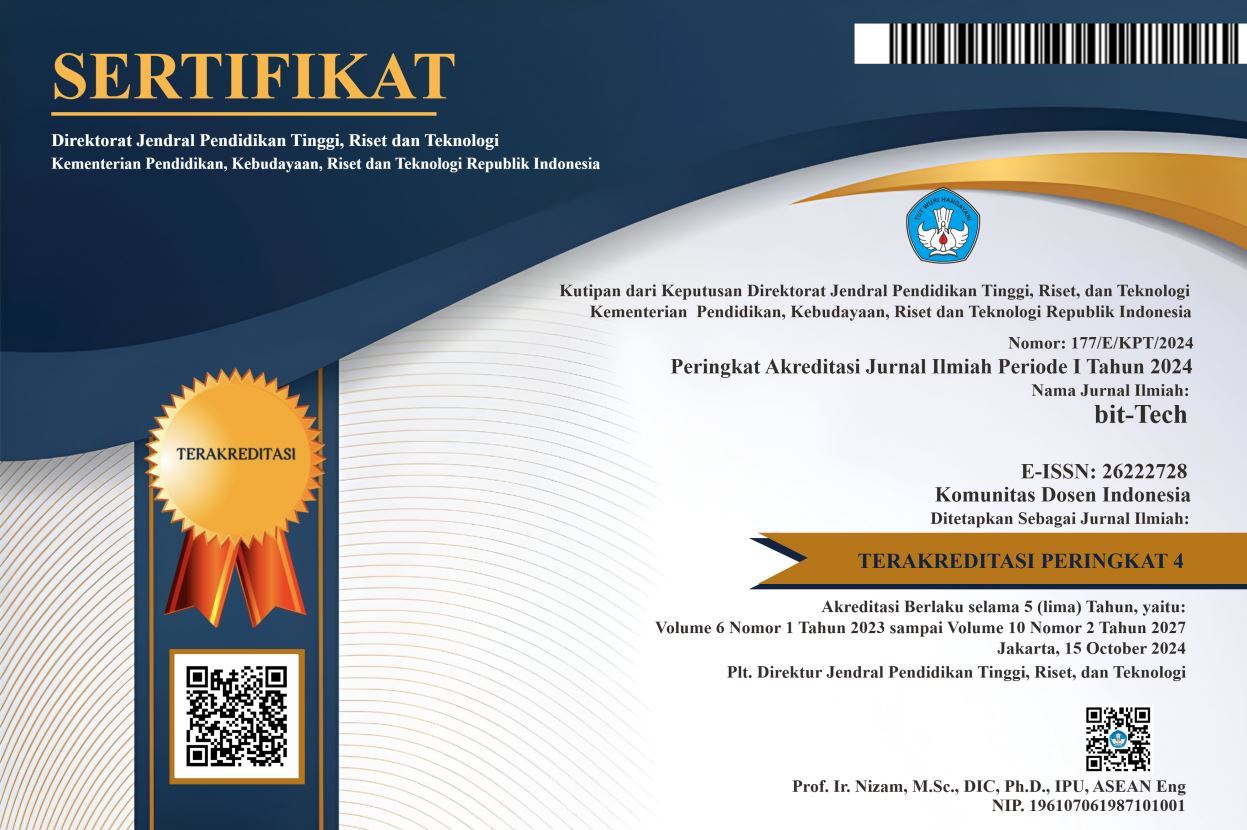Application of Data Mining to Predict Product Sales Using the K-Means Method
Keywords:
Clustering, Data Mining, K-means Algorithm, Predict Future Sales, Sales
Abstract
Sales activities that run every day generate large amounts of transaction data which can become data stacks. This also happened in a bag-selling shop called Toko Blessing. Toko Blessing is a bag sales business that focuses on children's school supplies with various categories such as school bags, drink bottle bags, and lunch box bags which have several variants of models and motifs in each category. With so many product variations and manual reporting, Toko Blessing faces difficulties in determining which products are best-selling and need to be added in large quantities to meet buyer demands and avoid the accumulation of less desirable products. With the availability of large sales data, if processed properly this data can be used to design the right business strategy. The K-means method is used because it makes it easier for the store to analyze and classify data to find out the level of the product through large amounts of sales transaction data that can be done quickly. The K-means method aims to determine sales patterns by looking at Blessing Shop sales transactions to help find out which products are often sold/best-selling and to predict future sales. From the data mining application using the K-means method, sales reports were generated based on sales transaction data from January 2021 to December 2022 totaling 1,188 data, which can later be used to assist Blessing Stores in making decisions on which products are superior to predict sales in the coming year.
Downloads
References
Normah, S. Nurajizah, and A. Salbinda, “Penerapan Data Mining Metode K-Means Clustering Untuk Analisa Penjualan Pada Toko Fashion Hijab Banten,” J. Tek. Komput. AMIK BSI, vol. 7, no. 2, pp. 158–163, 2021, doi: 10.31294/jtk.v4i2.
A. F. Budiantara and C. Budihartanti, “Implementasi Data Mining Dalam Manajemen Inventory Pada Pt. Mastersystem Infotama Menggunakan Metode Algoritma Apriori,” PROSISKO J. Pengemb. Ris. dan Obs. Sist. Komput., vol. 7, no. 1, Mar. 2020, doi: 10.30656/prosisko.v7i1.2130.
Nawassyarif, M. Julkarnain, and K. Rizki Ananda, “Sistem Informasi Pengolahan Data Ternak Unit Pelaksana Teknis Produksi Dan Kesehatan Hewan Berbasis Web,” J. Inform. Teknol. dan Sains, vol. 2, no. 1, pp. 32–39, 2020, doi: 10.51401/jinteks.v2i1.556.
H. Situmorang, “Sistem Informasi Pengelolahan Data Alumni Berbasis Web (Studi Pada Fakultas Sain, Teknologi Dan Informasi) Universitas Sari Mutiara Indonesia,” J. Mahajana Inf., vol. 4, no. 1, pp. 34–48, 2019.
J. Nasir, “Penerapan Data Mining Clustering Dalam Mengelompokan Buku Dengan Metode K-Means,” Simetris J. Tek. Mesin, Elektro dan Ilmu Komput., vol. 11, no. 2, pp. 690–703, Oct. 2020, doi: 10.24176/simet.v11i2.5482.
A. M. Retta, A. Isroqmi, and T. D. Nopriyanti, “Pengaruh Penerapan Algoritma Terhadap Pembelajaran Pemrograman Komputer,” Indiktika J. Inov. Pendidik. Mat., vol. 2, no. 2, pp. 126–135, May 2020, doi: 10.31851/indiktika.v2i2.4125.
Y. Dharma Putra, M. Sudarma, and I. B. A. Swamardika, “Clustering History Data Penjualan Menggunakan Algoritma K-Means,” Maj. Ilm. Teknol. Elektro, vol. 20, no. 2, p. 195, 2021, doi: 10.24843/mite.2021.v20i02.p03.
Maydianto and Muhammat Rasid Ridho, “Rancang Bangun Sistem Informasi Point of Sale Dengan Framework Codeigniter Pada Cv Powershop,” J. Comasie, vol. 4, no. 2, pp. 50–59, 2021, [Online]. Available: http://ejournal.upbatam.ac.id/index.php/comasiejournal/article/view/3173
R. H. Taufik and A. Leo, “Analisis Dan Perancangan E-Commerce Berbasis Web Penjualan Dan Stok Barang Market Digital Pada Pt. Mahajaya Plastindo …,” Akselerator J. Sains Terap., vol. 3, no. 2, pp. 83–94, 2022, [Online]. Available: https://jurnal.buddhidharma.ac.id/index.php/aksel/article/view/1858%0Ahttps://jurnal.buddhidharma.ac.id/index.php/aksel/article/download/1858/1164
A. Sudarso, “Pemanfaatan Basis Data, Perangkat Lunak Dan Mesin Industri Dalam Meningkatkan Produksi Perusahaan (Literature Review Executive Support System (Ess) for Business),” J. Manaj. Pendidik. Dan Ilmu Sos., vol. 3, no. 1, pp. 1–14, 2022, doi: 10.38035/jmpis.v3i1.838.
Dermawan, D. S. D. Putra, and L. W. Kusuma, “Aplikasi Pendaftaran Seminar Menggunakan Metode Mvc Berbasis Website Menggunakan Framework Codeigniter 3.1.10,” J. Algor, vol. 1, no. 2, 2020.
R. D. Safitri, A. Susanto, R. Rino, and L. W. Kusuma, “Rancang Bangun Aplikasi Absensi Sekolah Minggu Dengan Pengenalan Wajah Menggunakan Principal Component Analysis (Pca) Pada Gereja Gbi Modernland,” Algor, vol. 2, no. 2, pp. 31–40, 2021, doi: 10.31253/algor.v2i2.567.
V. R. Prasetyo, H. Lazuardi, A. A. Mulyono, and C. Lauw, “Penerapan Aplikasi RapidMiner Untuk Prediksi Nilai Tukar Rupiah Terhadap US Dollar Dengan Metode Linear Regression,” J. Nas. Teknol. dan Sist. Inf., vol. 7, no. 1, pp. 8–17, 2021, doi: 10.25077/teknosi.v7i1.2021.8-17.
A. Hendri and A. S. Mochammad, “Sistem informasi pelaksanaan kegiatan komisi kepolisian nasional berbasis desktop,” J. CoSciTech (Computer Sci. Inf. Technol., vol. 2, no. 1, pp. 14–23, 2021, doi: 10.37859/coscitech.v2i1.2393.
Gustientiedina, M. H. Adiya, and Y. Desnelita, “Penerapan Algoritma K-Means Untuk Clustering Data Obat-Obatan,” J. Nas. Teknol. dan Sist. Inf., vol. 5, no. 1, pp. 17–24, 2019, doi: 10.25077/teknosi.v5i1.2019.17-24.
Downloads
Published
How to Cite
Issue
Section
License
Copyright (c) 2023 bit-Tech : Binary Digital - Technology

This work is licensed under a Creative Commons Attribution-ShareAlike 4.0 International License.
I hereby assign and transfer to bit-Tech all exclusive copyright ownership rights to the above work. This includes, but is not limited to, the right to publish, republish, downgrade, distribute, transmit, sell, or use the work and other related materials worldwide, in whole, or in part, in all languages, in electronic, printed, or any other form of media, now known or hereafter developed and reserves the right to permit or license a third party to do any of the above. I understand that this exclusive right will belong to bit-Tech from the date the article is accepted for publication. I also understand that bit-Tech, as the copyright owner, has sole authority to license and permit reproduction of the article. I understand that, except for copyright, any other proprietary rights associated with the work (e.g. patents or other rights to any process or procedure) must be retained by the author. In addition, I understand that bit-Tech permits authors to use their papers in any way permitted by the applied Creative Commons license.


 Abstract views: 122
/
Abstract views: 122
/  PDF downloads: 165
PDF downloads: 165











